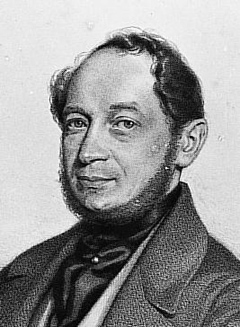
Alois Negrelli - master of transport constructions and knight from the Vltava and Elbe
 |
The Prague viaduct, designed by Negrelli together with Czech engineer Jan Perner, was built between 1846 and 1849. The bridge leading from Masaryk Station through Karlín and Štvanice Island to Bubny had to conquer an immense riverbed full of mud from the then unregulated Vltava River. At the time of its creation, with a length of 1,111 meters and 87 arches, it was a world unique. It is now the second oldest standing bridge over the Vltava.
However, the Karlín viaduct is by no means the most significant construction that Negrelli contributed to. That distinction undoubtedly belongs to the Suez Canal, for whose realization the French engineer and diplomat Ferdinand de Lesseps specifically chose Negrelli's design. Negrelli had previously demonstrated that the levels of the Mediterranean and the Red Sea are nearly equal and that locks would not be necessary, as many opponents of the canal had claimed. However, Negrelli did not participate in the actual construction (he was appointed head of technical management) - he died about six months before the ceremonial groundbreaking.
Negrelli is associated with several other significant projects. In addition to building railways and bridges, he also participated in regulating river flows, such as the Rhine and allegedly some Czech rivers. Some of his lesser-known works include the viaduct near Verona, the stone bridge Nydeckbrücke in Bern, Switzerland, or the Corinth Canal in Greece between the Aegean and Ionian Seas.
Alois (Luigi) Negrelli von Moldelbe was born on January 23, 1799, in an Italian-speaking family in the South Tyrolean village of Fiera di Primiero, which was at that time part of the Habsburg monarchy (now Italy). He studied in the northern Italian towns of Feltre and Padua. He began his career in Tyrol, where he contributed to the regulation of alpine rivers and the reconstruction of mountain paths into roads.
He briefly studied in Vienna, where he met František Gerstner and his horse-drawn railway from České Budějovice, but he initially rejected his offer to build railways. He then moved to Bregenz, where he worked on the regulation of the Rhine and earned a reputation as an expert on water flows. He later worked in St. Gallen, Switzerland, as an inspector for road and water construction and in Zurich, where he designed the stone bridge Münsterbrücke.
His travels across Western Europe and his time in Switzerland gave him considerable experience in technical civil engineering, particularly in railway construction. He later applied this expertise as a builder of the first railways in Austria-Hungary. He was appointed Chief Inspector of the Northern Railway of Emperor Ferdinand, which was constructing the line from Vienna through Olomouc to Galicia, and he was very successful in this role. In addition to significant income, he also received several other honors, including being named an honorary citizen of Olomouc.
Subsequently, he was tasked with overseeing the construction of the northern branch of the state railways from Vienna to Prague and Děčín. Thanks to his efforts, the first train arrived from Olomouc to Prague on August 20, 1845 (where he also received honorary citizenship). In 1848, he was appointed head of the ministry section and managed the construction of other lines as well. Later, at the request of Marshal Radetzky, he was called to northern Italy, where he led the reconstruction of roads, bridges, and lines damaged during civil unrest. Here, he made a number of successful transport constructions, as well as contributing to the preservation of some monuments.
The fact that he cared not only about the technical parameters of construction but also respected monuments and nature is evidenced by an incident from Bohemia. At the time he was personally overseeing the construction of the railway to Děčín, he reportedly advocated for the preservation of picturesque sandstone cliffs above the Vltava River near Nelahozeves. He is said to have loved the landscape so much that when Emperor Franz Joseph I elevated him to the nobility, he accepted the surname Ritter von Moldelbe - Knight of the Vltava and Elbe. According to another version, as a native Italian and nationalist, he protested against the Habsburg monarchy by composing the noble predicate from the names of Czech rivers. During his stay in Italy, he earned temporary disfavor at the Viennese court due to his sympathies for the rebels.
The English translation is powered by AI tool. Switch to Czech to view the original text source.
0 comments
add comment
Related articles
0
01.06.2020 | Praha will apply for a zoning decision in the summer for the adjustment of the area around the viaduct
0
29.05.2020 | The Negrelli Viaduct will open on Monday, it's the first section to the airport
0
29.05.2020 | The Negrelli Viaduct is the second oldest standing bridge in Prague
0
27.05.2020 | Trains will return to the repaired Negrelli viaduct on June 1st
0
30.09.2019 | The traffic will return to Prague's Negrelli Viaduct on June 1, 2020
0
18.02.2018 | Workers removed a section of the railway bridge being repaired in Karlín
0
08.06.2017 | The repair of the Negrelli Viaduct will allow for higher train speeds
5
07.06.2017 | On Thursday, the reconstruction of the Negrelli Viaduct in Karlín will begin
0
11.05.2017 | The railway administration signed a contract for the repair of the Negrelli Viaduct
0
27.09.2016 | <!DOCTYPE html>
<html>
<head>
<title></title>
</head>
<body>
<p>The Railway Administration wants to repair the Negrelli Viaduct for 1.2 billion CZK</p>
</body>
</html>
0
30.05.2010 | The Negrelli Viaduct has arched over the Vltava River for 160 years












